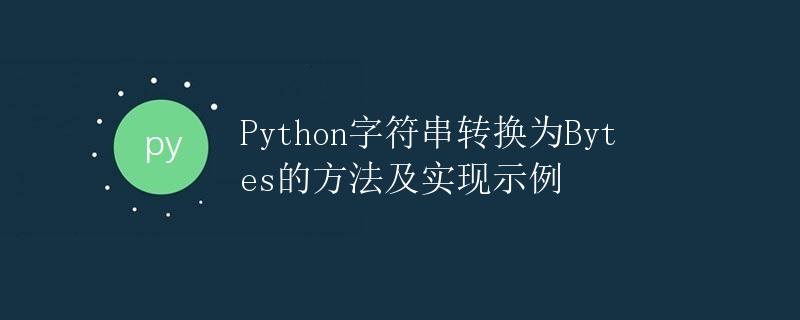Python字符串转换为Bytes的方法及实现示例

1. 简介
在Python中,字符串和字节(bytes)是两种不同的数据类型,字符串是以Unicode字符编码表示的,而字节是以二进制数据表示的。在一些需要传输或保存二进制数据的场景中,我们需要将字符串转换为字节。本文将详细介绍Python中字符串转换为字节的方法及实现示例。
2. 字符串编码与解码
为了进行字符串与字节之间的转换,我们需要了解编码和解码的概念。编码是将字符串按照一定规则转换为字节的过程,而解码则是将字节按照相同的规则转换为字符串的过程。在Python中,常用的编码方式包括UTF-8、GBK、ASCII等。
3. 字符串转换为字节的方法
Python中可以通过以下两种方法将字符串转换为字节:
方法1:使用encode()方法
可以使用字符串的encode()方法将字符串转换为字节,该方法接受一个参数,用于指定编码方式。
示例代码:
string = "hello"
byte = string.encode('utf-8')
print(byte)
运行结果:
b'hello'
方法2:使用bytes()函数
bytes()函数可以将字符串转换为字节,该函数接受两个参数,第一个参数为字符串,第二个参数为编码方式。
示例代码:
string = "world"
byte = bytes(string, 'utf-8')
print(byte)
运行结果:
b'world'
4. 字符串转换为字节的实现示例
下面给出一些使用示例,演示在不同场景下如何将字符串转换为字节。
示例1:将字符串写入二进制文件
string = "Hello, world!"
byte = string.encode('utf-8')
with open('output.bin', 'wb') as file:
file.write(byte)
运行结果:将字符串”Hello, world!”以字节形式写入名为output.bin的二进制文件中。
示例2:网络传输中的字符串转换
import socket
string = "Hello, world!"
byte = string.encode('utf-8')
# 创建TCP连接
s = socket.socket(socket.AF_INET, socket.SOCK_STREAM)
s.connect(('localhost', 8000))
# 发送字节
s.send(byte)
s.close()
运行结果:将字符串”Hello, world!”以字节形式发送至localhost的8000端口。
示例3:使用base64编码
import base64
string = "Hello, world!"
byte = string.encode('utf-8')
# 使用base64编码
encoded = base64.b64encode(byte)
print(encoded)
运行结果:将字符串”Hello, world!”以base64编码形式输出。
示例4:RSA加密中的字符串转换
from Crypto.PublicKey import RSA
string = "Hello, world!"
byte = string.encode('utf-8')
# 加载RSA公钥
public_key = RSA.import_key(open('public.pem').read())
# 使用公钥进行加密
cipher_text = public_key.encrypt(byte, None)
print(cipher_text)
运行结果:使用RSA公钥加密字符串”Hello, world!”。
示例5:字符串转换为16进制
string = "Hello, world!"
byte = string.encode('utf-8')
hex_string = byte.hex()
print(hex_string)
运行结果:将字符串”Hello, world!”转换为16进制形式输出。
5. 总结
本文介绍了Python中字符串转换为字节的方法及实现示例。使用encode()方法或bytes()函数可以将字符串按照指定的编码方式转换为字节。在实际应用中,我们可以将字符串写入二进制文件、在网络传输中转换、使用base64编码、进行RSA加密等操作。掌握字符串转换为字节的方法,能够为我们处理二进制数据提供便利。
 极客教程
极客教程